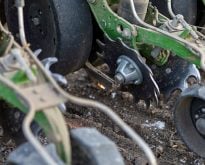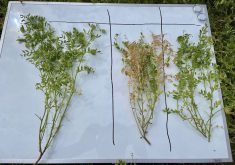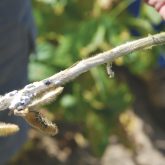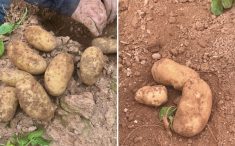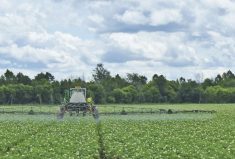In the world of agriculture, there are very few constants. Most practices and standards last only until new research shifts our thought processes, or until a new challenge or a new opportunity changes the landscape.
There are plenty of recent examples. Within the past decade, the hard-and-fast rule of always planting corn first has changed; sometimes it’s better to get the beans in and go back to finish the corn when the conditions are right. Another is the rule about cold-water imbibition. As recently as seven years ago, this was something to avoid if at all possible. Today we hear less about cold water uptake, and maybe it’s because of the hardiness of soybean seed or maybe it’s because our weather is getting warmer.
Read Also

Sensing the soil: Root cell research finds ‘stress hormone’
Research into how root cells react to soil stressors could help plants better adapt to changes in their climate.
Bottom line, standards are always changing.
Now it’s happening with seed inoculant too. Until a decade ago the clear consensus among agronomists was that the only ground where it makes sense to inoculate is in first-time soybean fields. Why waste that money when soils that have had soybeans in the rotation already contain high numbers of the nitrogen-fixing rhizobia bacteria?
Well, farmers spend it because it’s inexpensive insurance and it guarantees the right source of rhizobia in the ground, helping to establish those nodules and get the plant fixing its own fertilizer.
According to Horst Bohner, soybean specialist with the Ontario Ministry of Agriculture, Food and Rural Affairs (OMAFRA), inoculating — or pre-inoculating — soybeans is now just one more function of treating seed or the soil during the course of the planting season. It’s becoming as automatic as other seed treatments, or the notion of fertilizing soybeans with potash. Such practices may not have been part of the plan 10 years ago, but they’re becoming more front-of-mind today.
“We’re trying to make things as convenient as possible for the producer because of acreage, speed, and size,” says Bohner, who has completed a six-year study on the impact of inoculants in soybeans. “So the trend to pre-inoculants has been pretty good, and there are some real benefits to that.”
The more that’s learned from research, the more often inoculants are being recommended. In past, it was enough to inoculate new soybean ground. But as Bohner has found, soil rhizobia on their own need a boost, hence the current trend towards pre-inoculants as a seed treatment, even on fields with a history of soybeans.
Bohner adds that in 2014, there were many fields with poor nodulation, mostly due to the cold spring conditions. Some producers he met had several hundred acres of first-time soybeans with no nodules, even though an inoculant had been applied. Some of those failures, he notes, could have been magnified by the reliance on a single application such as a liquid inoculant or a pre-inoculant. Generally, it’s been found that if two products are used on first-time fields, there are fewer nodulation problems.
“It’s not just in those fields, and it’s not just the pre-inoculants, but certainly it’s about getting the right bacterial numbers on the seed,” says Bohner. “We need to be careful in first-time fields, and that’s what we learned again (in 2014), that a single pre-inoculant is not good enough; they need to put on two products to get around the issue of nodulation failures on first-time fields.”
Despite the changing mindset in using inoculants and pre-inoculants, the bacterial strain used as an inoculant hasn’t changed since the early 2000s. It was in 2002 that Dr. Dave Hume, professor emeritus at the University of Guelph, was testing the addition of Bacillus subtilis to the standard inoculant strain of Bradyrhizobium japonicum. On its own, B. subtilis is a common, naturally-occurring bacterium, but added to the rhizobium strain, it acts as a plant growth promoting rhizobacterium (PGRP), which in some fields stimulates early growth in soybeans. It is not, however, an inoculant by itself.
Bohner is aware of companies that are researching new strains — some from South America — but none of those are commercially available for use at this time. What he does see coming in the future is an uptake in biostimulants, plus nematode control or other products to allow better nutrient uptake. But his take-home message for the time being is that there’s no reason not to inoculate.
“I think every field in the province — every year — should get an inoculant,” says Bohner. “It doesn’t hurt, and there’s a small net benefit to the producer for doing that on every field, every year. And 2014 was one of those years where it was cool and wet in the spring, and if you have an inoculant it just puts the nodules on a little bit faster. Is it going to change the world? No, it’s about a bushel to 1.5 bushels per acre on average, but it doesn’t cost that much to put on, so why not do it?”

For Mike Verhoef, relying on inoculants is more one of those “getting back to basics” approaches that are earning more attention from farmers, agronomists, advisers, retailers and company representatives. He confirms Bohner’s statement about the companies being involved in more research into newer strains, but also the use of polymers, colourants and seed application processes. And he echoes Bohner’s contention that we need to be more specific with terminology and the differences between the inoculant (Bradyrhizobium japonicum) and the growth promoter (Bacillus subtilis).
Instead, he wants to focus on the farmer’s primary investment — the high-value, “traited” seed.
“By putting an inoculant on that seed, you’re guaranteeing that that seed has instant access to healthy, robust rhizobia and that it’s ready to start self-affixing nitrogen through the production of nodules,” says Verhoef, national seed company manager with BASF Canada. “Even though they’ve grown soybeans on that field before, and there will be rhizobia there, it doesn’t mean that there are the healthy robust rhizobia that it needs.”
Verhoef adds that he’s glad to have Bohner making the point about inoculation being an inexpensive form of insurance, and remembers his presentation at the Southwest Agricultural Conference in 2012. That day, Bohner spoke of his six-year study on inoculants and how there was little need for more study or analysis, just that inoculating works, so why not do it?
“If you ask any soybean expert, U.S. side or Canadian side, what are a few of the key things you must do on soybean production, inoculant is in the top three,” says Verhoef.
In Western Canada, where growers are becoming more familiar with soybeans and corn, they’re already sold on the benefits of inoculating. With a new pea and lentil inoculant — capable of boosting yield between seven and 11 per cent — most growers in the West place inoculating on a scale of importance above seed treatments. So in that sense, says Verhoef, Western Canada producers are ahead of those in the East, where he says the industry is still encountering the notion that soybean ground needs no inoculant, unless it’s first-time ground.
“You could comfortably say that companies like ours are always looking for improvements in strains, improvements in formulation and improvements in carriers,” says Verhoef. “To do that, we’re always looking at new biologicals to add, to make that whole process work better. The biggest interest right now is this whole ‘ease-of-use’ and on-seed movement and making it easier for the grower, so we’ve put a lot of focus into that in the last five years — hence the whole pre-inoculant situation. But as we do that, ease-of-use is also part of lowering the application use rates, longer days on seed and the formulation processes.”
Research also continues into a formulation process to put more living bacteria in a smaller amount of product.
This article was published in the Soybean Guide, February 2015 edition
East versus West terminologies
A point of interest in the world of inoculants is the use of terms like “double inoculation.” It’s used more in Western Canada, says Mike Verhoef, national seed company manager for BASF Canada. In Eastern Canada, the term is “full-rate” but in the final analysis, it’s the same thing.
In the West, half-rate is applied as a liquid pre-inoculant directly on the seed. Then, farmers typically apply an in-furrow inoculant, hence the “double” terminololgy. It’s actually the full-rate that some growers apply in the East (a pre- and then an in-furrow inoculant).
In Western Canada, growers also use their “double-rate” inoculants as a standard application.




